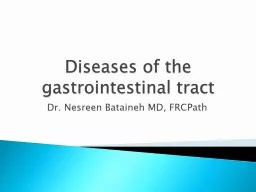

Dr Nesreen Bataineh MD FRCPath STOMACH Congenital disorders Gastric heterotopia Diaphragmatic hernia Pyloric stenosis Gastritis Gastric ulceration Tumors Gastric disorders ID: 909507
Download Presentation The PPT/PDF document "Diseases of the gastrointestinal tract" is the property of its rightful owner. Permission is granted to download and print the materials on this web site for personal, non-commercial use only, and to display it on your personal computer provided you do not modify the materials and that you retain all copyright notices contained in the materials. By downloading content from our website, you accept the terms of this agreement.
Slide1
Diseases of the gastrointestinal tract
Dr.
Nesreen
Bataineh
MD,
FRCPath
Slide2STOMACH
Slide3Congenital disorders
Gastric
heterotopia
Diaphragmatic hernia
Pyloric stenosisGastritisGastric ulceration Tumors
Gastric disorders
Slide4Definition:
“Inflammation of the gastric mucosa”.
Acute gastritis
Chronic gastritis
(majority of cases).Gastritis
Slide5Definition:
“An acute inflammation of gastric mucosa”.
Usually of a
transient
nature. May be accompanied by hemorrhage and erosion UGIT hemorrhage.Acute Gastritis
Slide6Pathogenesis
Acute gastritis is frequently associated with:
Heavy use of
NSAIDs
, particularly aspirin
Excessive
a
lcohol
consumption and heavy
smoking
Severe
stress
(e.g., trauma, burns, surgery)
Anticancer
chemotherapeutic drugs
Systemic bacterial or viral infections
(e.g.,
salmonellosis
or CMV
)
Uremia
Ischemia and shock
Suicidal attempts (e.g., acids and alkali)
Gastric radiation
Mechanical trauma (e.g.,
nasogastric
intubation)
Following
antrectomy
with re
flux of bilious material
Slide7Slide8Gross appearance:
Localized (as in NSAID)
OR
diffuse.
Superficial inflammation OR Acute erosive gastritis: Inflammation involves the entire mucosal thickness with hemorrhage & focal erosions. Morphology
Slide9Acute
errosive
gastritis
Slide10Microscopic appearance:
Mucosal edema
Inflammatory infiltrate rich in
neutrophils
+ Erosions, hemorrhage & regeneration of epithelial cellsRemoval of the cause may lead to complete restitution of the normal mucosa.Morphology
Slide11Acute gastritis
Slide12Depends on the
severity
.
May be asymptomatic
Epigastric pain, nausea and vomitingHematemesis, melena or potentially fatal blood loss. It is one of the major causes of hematemesis.Clinical Features
Slide13Definition:
“The presence of
chronic inflammatory
changes in the gastric mucosa leading to
mucosal atrophy + epithelial metaplasia”.Chronic Gastritis
Slide14The major etiologic associations
Chronic infection by H. pylori,
most important
Autoimmune
:
Pernicious anemia (10%)
Toxic:
A
lcohol and cigarette smoking
Postsurgical:
F
ollowing
antrectomy
with
gastroenterostomy
and reflux of bile
Motor and mechanical:
Obstruction, bezoars* ,
and gastric
atony
Granulomatous
conditions
(e.g.,
Crohn
disease)
Miscellaneous:
U
remia, Radiation.
Slide15The most common GI infection.
A worldwide pathogen with the highest infection rates in
developing countries
(
Low socioeconomic status).In developed countries, the infection rate is 50% in adults > age 50.
Most individuals have
asymptomatic gastritis
~10%
develop peptic ulcer*.
Helicobacter pylori
Slide16Slide17H. pylori
is a
noninvasive
curvilinear gram-negative rod.
Mechanism of tissue injuryDirect (Bacterial virulence):Flagella: allow the bacteria to be motile in viscous mucus.
Urease
: generates ammonia from urea
elevating gastric pH around the organisms and protecting it from the acidic secretions.
Adhesins
: enhance bacterial adherence to surface
foveolar
cells.
Toxins
, such as that encoded by
cytotoxin
-associated gene A (
CagA
), proteases and
phospholipase
.
Indirect:
Bacterial products lead to:
↑
production of cytokines as IL-1, IL-6 … that recruits inflammatory cells with subsequent inflammation and tissue damage.
Pathophysiology
Slide18Antral
-type gastritis (commoner):
High HCL production (
hyperchlohydria
)*.Higher risk for the development of DU.Pangastritis:Multifocal mucosal atrophylow HCL production (hypochlorhydria
)
Increased risk for intestinal
metaplasia
&
adenocarcinoma
.
H. Pylori associated gastritis
Slide19H. pylori
↑
gastric acid secretion
and impairs duodenal bicarbonate production.
↓ luminal pH in the duodenum.This favor gastric metaplasia in the first part of the duodenum D1. Such metaplastic
foci provide areas for H. pylori colonization.
Peptic
duodenitis
Slide20Gastric
metaplasia
Slide21Chronic inflammatory infiltrate in the lamina
propria
.
Predominance of lymphocytes & plasma cell
Neutrophilic infiltration indicates activity.Gland loss and mucosal atrophy. Morphology of chronic gastritis
Slide22Chronic gastritis
Slide23H.
pylori
related gastritis
Organisms seen within the mucus layer overlying the superficial mucosal epithelium
Giemsa
Silver
Slide24Complications
Peptic ulcer
Duodenal
ulcer or gastric ulcer
Intestinal
metaplasia
:
The replacement of gastric epithelium with
intestinal epithelium including goblet cells
.
Dysplasia
Intestinal type
adenocarcinoma
Gastric lymphoma
Marginal zone lymphoma of MALT-type.
H. pylori related gastritis
Slide25Intestinal
metaplasia
Slide26High grade dysplasia
Slide27Clinical Features
Asymptomatic
Upper abdominal discomfort, N & V
May be
hypochlorhydric* (pangastritis), but these persons do not develop achlorhydria or pernicious anemia.Serum gastrin levels are either normal or only modestly elevated. H.pylori associated gastritis
Slide28Diagnosis:
Noninvasive tests:
Serologic test for anti–
H. pylori antibodies
Fecal bacterial detectionThe urea breath test based on the generation of ammonia by bacterial urease. Invasive tests: (
Antral
biopsy specimen*):
The rapid
urease
test, bacterial culture, or PCR
Histologic
identification of the organism
Treatment:
Triple therapy (two antibiotics and PPIs)
H. Pylori associated gastritis
Slide2910%
of cases of chronic gastritis
Common in
Scandinavians
. F>M.In association with pernicious anemia*.May be seen with other autoimmune diseases as Hashimoto thyroiditis and Addison diseaseProduction of autoantibodies to parietal cells and intrinsic factor that can be detected in serum and gastric secretions.
Autoimmune gastritis
Slide30Spares the
antrum
and
cardia.The autoimmune injury leads to gland destruction and diffuse mucosal atrophyLoss of parietal cells & intrinsic factorLoss of gastric acid (hypochlorhydria or achlorhydria)
Reduced serum pepsinogen I levels.
Hypergastrinemia
,
antral
endocrine cell hyperplasia
&
↑
risk of gastric
carcinoid
Increased risk of gastric carcinoma.
Autoimmune gastritis
Slide31Slide32H. pylori–Associated
Autoimmune
Loaction
Antrum
Fundus
& body
Inflammatory
infiltrate
Lymphocytes, plasma cells and
neutrophils
Lymphocytes, macrophages
Acid production
Increased to slightly decreased
Decreased
Gastrin
Normal (usually*)
Increased
Other lesions
Hyperplastic
/inflammatory polyps
Neuroendocrine
hyperplasia
Serology
Antibodies to
H. pylori
Antibodies to parietal cells or
intrinsic factor)
Sequelae
Peptic ulcer, adenocarcinoma
Diffuse Atrophy, pernicious anemia, adenocarcinoma,
carcinoid
tumor
Associations
Low socioeconomic status, poverty,
residence in rural areas
Autoimmune disease;
thyroiditis
, diabetes
mellitus, Graves disease
Characteristics of Chronic Gastritis
Slide33Periumbilical
pain that ultimately localizes to the right lower quadrant.
Nausea, vomiting & low-grade fever.
McBurney’s
sign.Mildly elevated peripheral white cell count.Complications:Appendiceal perforation.Peritonitis.Portal venous thrombosis.Liver abscess.Bacteremia.
Clinical Features
Slide34إزرَعْ
جَميلاً ولو في غَيرِ مَوضِعِهِ –
فَلا يَضيعُ جَميلٌ أينَما زُرِعا
إنَّ الجَميلَ وإن طالَ الزَّمانُ
بِهِ -- فَلَيس يَحصُدُه إلّا الذي زَرَعا